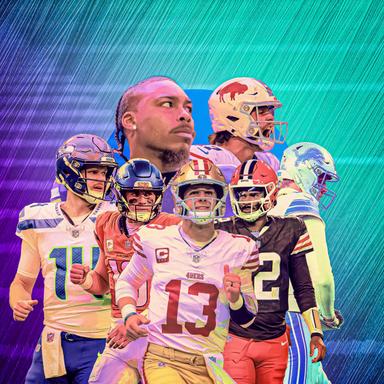Week 11 QB Notebook: Should the Vikings Bench J.J. McCarthy?
Welcome to the QB Notebook, a column covering the most interesting passers, plays, and story lines from the week in NFL quarterbacking. In this edition: J.J. McCarthy’s continued issues, Drake Maye’s high sack rate, and the best and worst throws from Sunday.
Welcome to The Ringer's quarterback notebook, where I’ll cover the past week in NFL quarterbacking—from the most interesting passers, plays, and story lines to some other stuff that caught my eye when watching film. In this week’s notebook, we’ll be looking at the root of J.J. McCarthy’s struggles, why I’m already out on the Kirk Cousins–led Falcons, Drake Maye’s high sack rate, and more. Let’s talk quarterbacks.
Should the Vikings bench J.J. McCarthy?
Quarterback evaluation is always tricky, especially when dealing with small sample sizes. But in the case of McCarthy, there’s a simple explanation for why he has yet to resemble an NFL quarterback through five career starts: He doesn’t throw the ball well. That’s the fundamental aspect of playing the position, and McCarthy won’t get the playing time to improve in other areas if he keeps throwing the ball with the accuracy and touch of a faulty Jugs machine.
McCarthy throws hard, but that doesn’t signal top-end arm talent. He’s a max-effort passer—even on a quick throw to the flat. This ball was caught, but you can see how the lack of control on the throw forced Adam Thielen to adjust and led to a collision with a defender.
McCarthy’s been the league’s least accurate quarterback through 11 weeks. Per Pro Football Focus, his 49.6 percent accuracy rate ranks last among the 43 passers with at least 50 attempts. He’s tied with Bryce Young for the league’s highest “catchable but inaccurate” throw rate. Sure, in Sunday’s loss against the Bears, there were some plays that Vikings receivers could have made but didn’t, but McCarthy didn’t make things easy on his teammates with his ball placement. He just doesn’t throw a very catchable ball.
The good news is that janky mechanics can be fixed over time … in theory. Outside of a few notable exceptions—like Aaron Rodgers and Josh Allen—we rarely see drastic improvement in this area. And Minnesota’s coaching staff has spent the past two offseasons working on McCarthy’s approach to throwing a football. Earlier this season, Vikings coach Kevin O’Connell had McCarthy working on his lower-body mechanics during what felt like the longest ankle sprain recovery in NFL history. Some theorized that holding McCarthy out was a “soft benching.” I don’t (fully) buy into that, but I’m starting to think that a soft benching might be best for everyone involved.
McCarthy is not playable in his current form, and he won’t be until he can fix his accuracy issue. That work should be done off the field and not at the expense of the rest of the offense during live games. Look what it’s doing to Justin Jefferson!
Right now, McCarthy is physically incapable of making the throws the Vikings passing game requires, and the problem is getting worse by the week. If the live reps aren’t helping him improve, then it might be time to give the second-year pro a break and turn to rookie backup Max Brosmer—whose preseason performance turned some heads—to try to make the passing game functional again.
The Baltimore Ravens should tap into Lamar Jackson’s superpower.
It’s easy to explain why Jackson and the Ravens struggled to score in their 23-16 win over Cleveland on Sunday: Myles Garrett was thrashing through the offensive line like a T. rex in Jurassic Park. That eventually unnerved Jackson, and he missed a few open opportunities downfield and ran into a few sacks. We’ve seen this sort of spiral from Jackson in the past. He loses faith in his pass protection and starts seeing ghosts. It’s one of the few notable holes in his game, and it has been a common denominator in his playoff failures.
On Sunday, though, Jackson worked through it and finished the game strong. He was the best player on the field for Baltimore’s offense—despite his inconsistencies. And even when he’s at his worst, the Ravens are better off when the ball is in Jackson’s hands. Which is why I’d like to see offensive coordinator Todd Monken call more more designed runs for him. Jackson is averaging just 2.7 designed runs per game, after getting 4.8 per game a season ago. He has been as explosive as ever on those runs this season, so production is not the reason for the decline. Maybe the Ravens are trying to preserve his legs for the playoffs, or maybe Jackson isn’t fully recovered from the hamstring injury that kept him out for a month.
Whatever the case may be, the fact that Baltimore is limiting Jackson’s run-game touches makes the offense a little less dynamic overall. It also changed the nature of the play-action pass game, which used to be built around option-style runs from shotgun. Jackson has been in the gun on only 30 percent of his play-action dropbacks in 2025. That number was at 53.5 percent in 2024, per TruMedia. You don’t really see NFL teams run option plays from under center, so it gives the defense one less thing to worry about when sorting out its play-action coverage plan.
It seems like Monken could squeeze more juice out of Jackon’s run threat down the stretch. I’m all for keeping the QB fresh for January, but the Ravens are still on the outside of the AFC playoff picture. And Sunday’s game shows how thin their margin for error is, even against the worst teams in the league.
This version of Kirk Cousins isn’t saving the Atlanta Falcons’ season.
With Michael Penix Jr. expected to miss the rest of the season with a knee injury, Atlanta’s fading playoff hopes now rest on Cousins, who looked tragically washed up in his first two appearances of the season. I fired up the film of his 14 dropbacks from Sunday’s overtime loss to the Panthers, looking for any sign that he has something left to give the 3-7 Falcons. I got one play in before I abandoned any hope I had.
Before I show you footage of that snap, let’s play a game called Guess Where He Threw It. Here’s the moment Cousins finished his drop on his first pass play of the game. It came after a play-action fake on first-and-10 early in the fourth quarter.
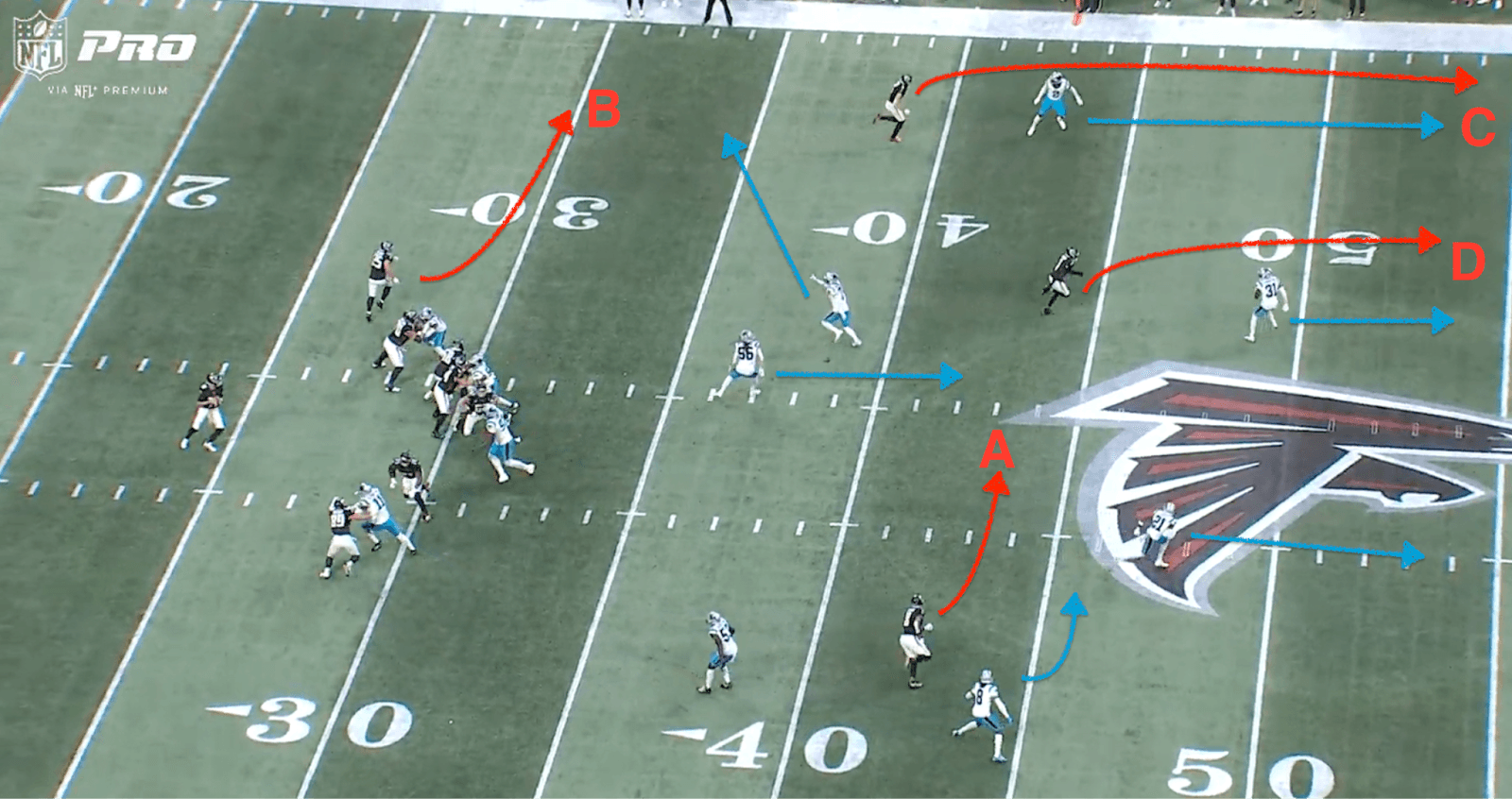
If you chose option A, Kyle Pitts running into the middle of the field with only a linebacker in position to stop him, you should have been correct. That’s the primary read against a look like that. But instead of making the throw downfield, Cousins immediately checked it down to the flat, undeterred by a linebacker who broke on the route before Cousins even started his throwing motion.
Look, I get that it’s one play, but that’s not a decision Cousins can be making if this is going to work. His utility throughout his career was based largely on his willingness to turn his back to the defense, fake a handoff, and fire a throw over the middle of the field on time. He’s the play-action quarterback of his generation. So watching the 37-year-old turn that option down without much thought was like watching Duncan Robinson pass out of an open 3. If he’s not making that play, he’s of very little use to the team.
Cousins didn’t target the middle of the field much at all against the Panthers.
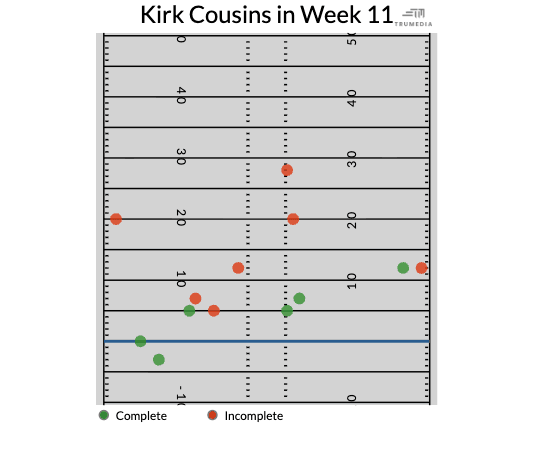
And the few throws he did make to the area fluttered through the air. This hopeless pass up the seam to Darnell Mooney should have been intercepted.
And he threw this backside dig straight into the turf on Atlanta’s final offensive snap of overtime.
I doubt that the Falcons were headed anywhere with Penix, who’s been up and down throughout the season, but we can write them off completely if this is the version of Cousins who shows up over the next seven weeks.
Is Drake Maye taking too many sacks?
Maye is having a fantastic season and is rightfully the leader in the MVP race, but the league’s new golden boy is not beyond criticism. There are some nits to pick in his game—specifically, his 10.1 percent sack rate, the fourth-highest mark in the league. Maye is also sporting a high pressure-to-sack rate, which can be a red flag for a young quarterback. At the very least, it’s worth asking: Are the sacks a concern for this rising star?
I’d say yes and no. It’s an issue any time a young quarterback is taking hits at a high rate. But after watching the film of every sack Maye has taken this season, I don’t believe that this is the result of any significant weakness in his skill set—at least nothing that should affect him in the long term. Many quarterbacks who take a lot of sacks have trouble processing or don't navigate the pocket well. Pocket presence and timing haven’t been issues for Maye this season. When he stays in the pocket, he flies through his progressions and takes sacks at a rate (5.8 percent) closer to the league average (5.3 percent).
Most of Maye’s sacks have come on plays in which he leaves the pocket to escape pressure or buy time for receivers to get open. He’s taken 20 sacks outside the pocket, while no other quarterback has taken more than 14. That’s not a good thing, but it means that Maye is often avoiding big losses when he does get taken down. He’s lost an average of 4.5 yards per sack, which ranks as the second-lowest mark in the league, behind only Jaxson Dart. He’s lost 0 to 2 yards on 14 of his sacks, which leads the league by a wide margin.
Maye could lop a big chunk off his out-of-pocket sack rate if he just threw the ball away instead of running out of bounds behind the line of scrimmage.
But Maye’s scrambling is a net positive for the team, and these aren’t drive-killing losses for the Pats offense. New England is scoring an average of 2.02 points on drives in which at least one sack was taken. Only the Chiefs and Rams have averaged more, per TruMedia. So, sure, more throwaways and fewer short sacks would make it harder to poke holes in Maye’s stat line, but it wouldn’t have a sizable effect on the Patriots’ offensive efficiency, which is finally back in a healthy spot thanks to the team’s 23-year-old star.
Brock Purdy is back, but he doesn’t look like himself yet.
Before I get accused of hating on Purdy’s three-touchdown outing in his return from a turf toe injury, I’d like to point out that PFF gave the 49ers quarterback a 61.6 passing grade for his Week 11 performance. That’s about the same grade Purdy earned for the Jaguars game that had everyone in San Francisco wondering why Kyle Shanahan had him playing through an injury. The results were different this time around, but Purdy still looks far from 100 percent.
I’m less concerned about Purdy’s decision-making and more concerned with how the ball looked coming out of his hand. Before the toe injury forced Purdy out of the lineup, he was having trouble pushing off his plant foot, which made it difficult to drive the football. Nothing really changed on Sunday, and we saw several looping throws and awkward deliveries. Even some of Purdy’s completions hung in the air.
Christian McCaffrey looked like he was fielding a punt while waiting for Purdy’s far-hash throw to get to him in the clip linked above.
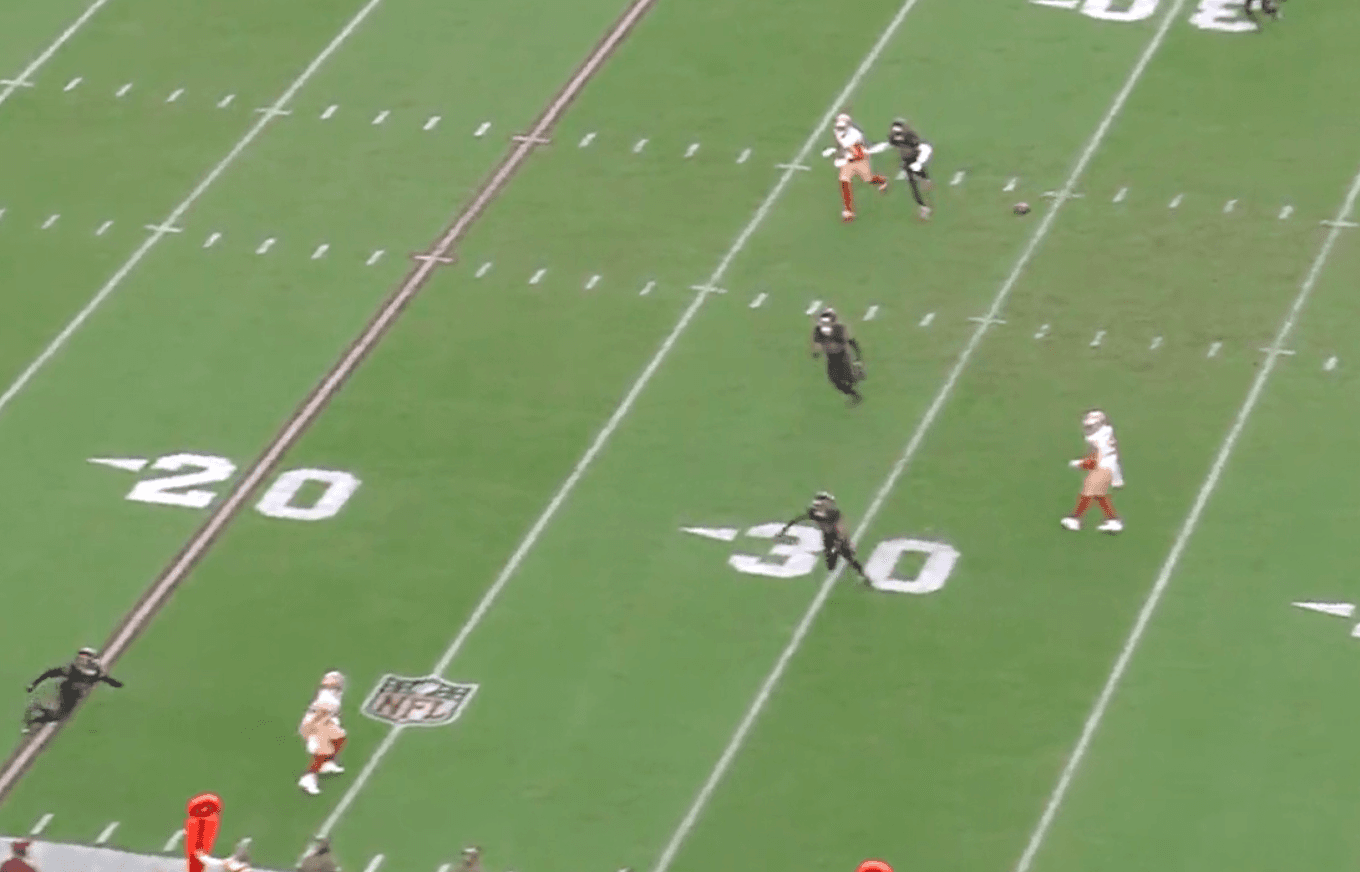
Purdy doesn’t have the strongest arm in the league, but he typically has more juice compared with what we saw against Arizona. And Purdy usually scrambles more often than he did on Sunday. He didn’t take off once against Arizona, another sure sign that he’s limited. As Purdy said earlier this season, “To be myself and play like myself, I have to move a bit.” This doesn’t look like the Purdy we’ve seen in the past two seasons. Not yet, anyway.
The Next Gen Stats passing map that will make an Eagles fan miserable.
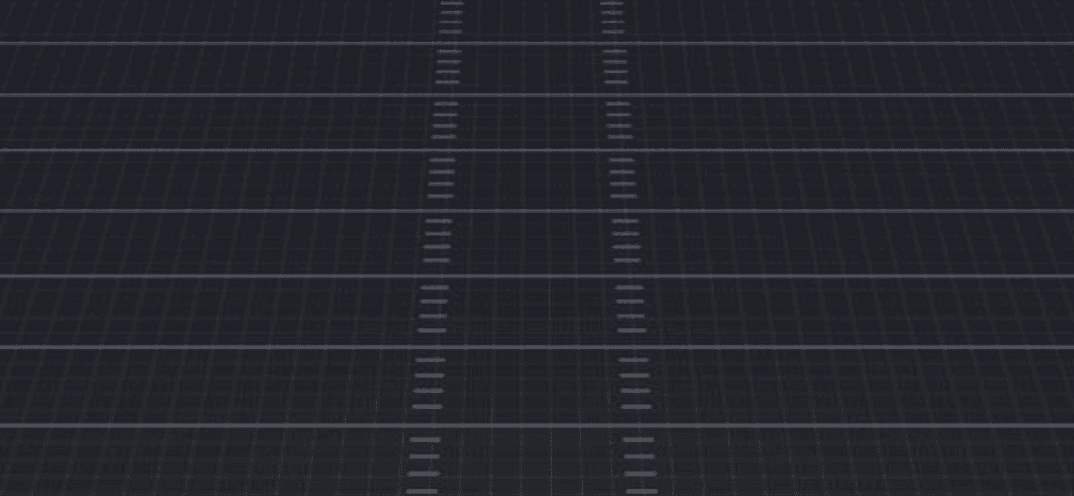
Whoops, sorry about that. Let me zoom out a little.
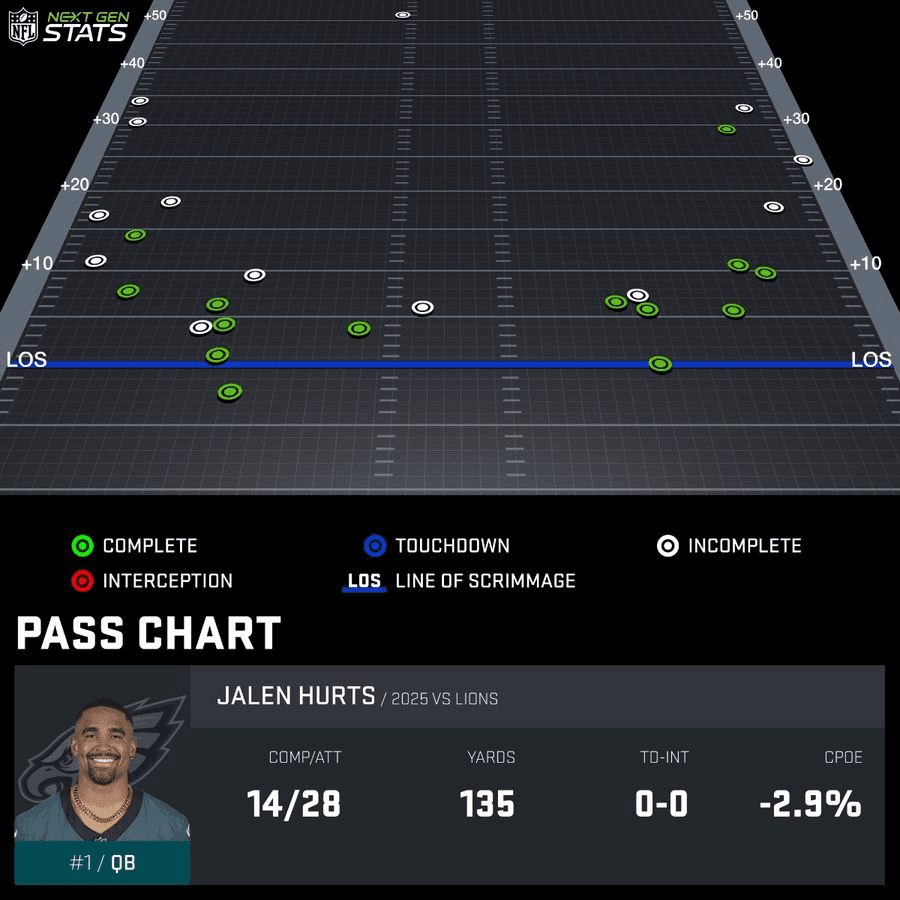
The Eagles won again on Sunday, a 16-9 victory over the Lions, but the passing game was inept once again. Maybe because both the quarterback and offensive coordinator ignored 85 percent of the field. It was a windy night in Philadelphia, and somehow Philly’s solution for dealing with that was to attack Detroit’s defense down the sideline with longer throws that required more air under them.
I’m not sure who deserves the most blame for that monstrosity of a passing map: Jalen Hurts or offensive coordinator Kevin Patullo. I’d lean more toward Patullo—this Philly passing game is poorly designed—but Hurts has also stayed away from the middle of the field under every coordinator he’s had.
This screenshot of Hurts seemingly ignoring an open DeVonta Smith downfield was widely shared after the game.
That image is a little misleading, but I do think that the play illustrates where Hurts needs to improve as a passer. Forget about Smith, who was actually covered up by the time Hurts moved on his progression:
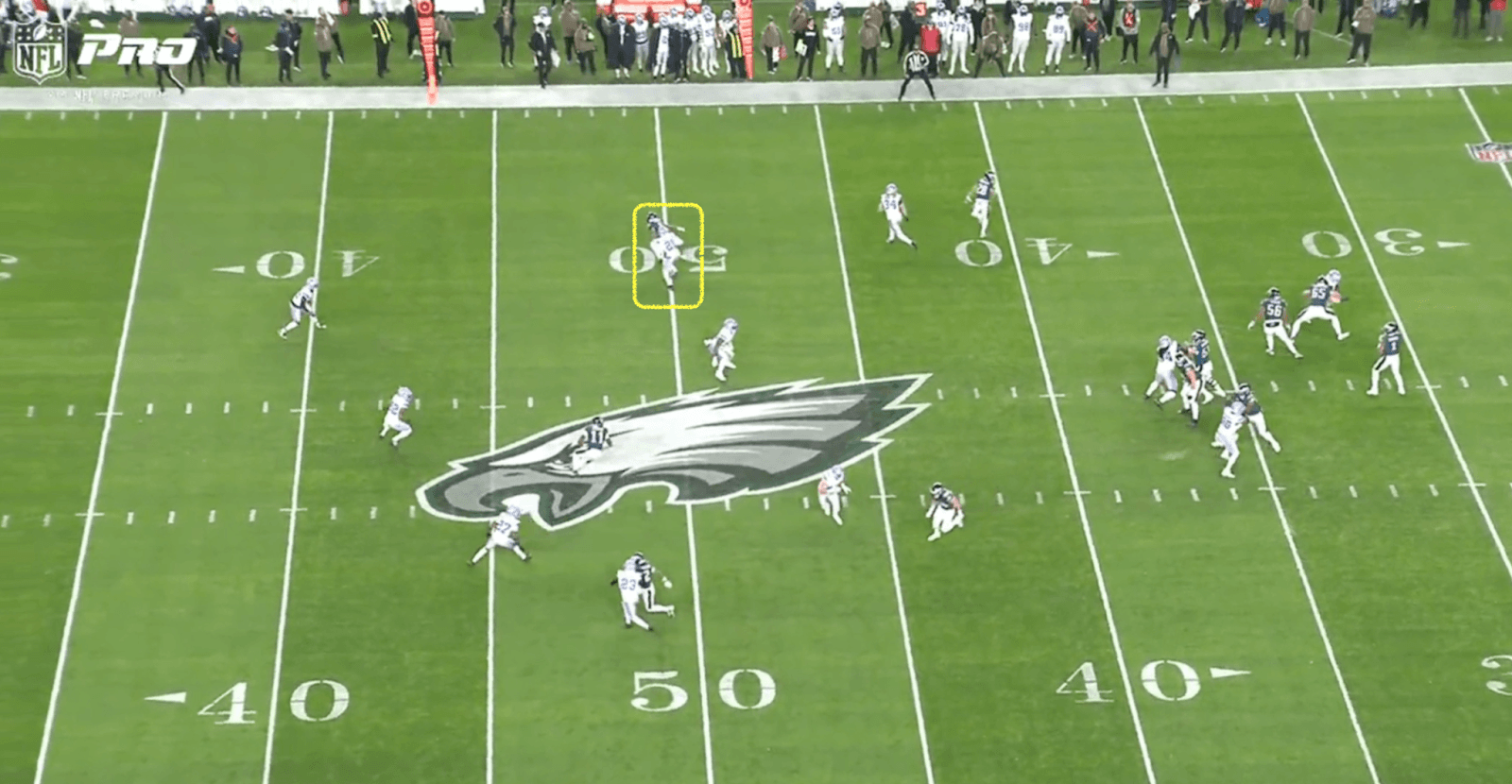
Instead, focus on A.J. Brown in the middle of the field.
That’s where the ball should have gone, and Hurts got his eyes there in time to make the throw. He just wasn’t ready to do it with the anticipation required. And by the time he was ready, the window was closed. It’s a difficult throw that requires next-level timing and arm strength, but it’s one you’d expect a highly paid quarterback to make—especially from a clean pocket. Here’s Jordan Love making a similar throw under a lot more pressure on Sunday.
There’s just a little bit of a lag for Hurts as he goes from one read to the next, but that can make a big difference when working the middle of the field, where windows are tighter and close in the blink of an eye. The coaching staff could be doing more to help Hurts out, but he’s also got to take the opportunities when they’re there.
The best throw(s) I saw this week.
Sunday was one of those days when the Packers receivers forgot how to catch a football, so Jordan Love won’t get much recognition for it, but he played one of the best games I’ve seen from a quarterback all season. He finished with a 12.1-yard average depth of throw and was charted with only one off-target throw, per TruMedia. He was also PFF’s highest-graded passer of the week. Love made several throws that could be picked as the best of the week.
The worst throw I saw this week.
Josh Allen is one of the best football players I’ve ever seen, and on Sunday, he threw maybe the worst interception I’ve ever seen.
A two-handed chest pass! Never seen anything like it. If that’s not the worst interception of all time, it’s on my Mount Rushmore. Along with Brandon Weeden’s backhanded flip:
Carson Wentz’s left-handed pick-six out his own end zone.
And Matt Cassel getting flagged for intentional grounding on an interception, which was so bad, even the official NFL YouTube account called it “terrible.”




